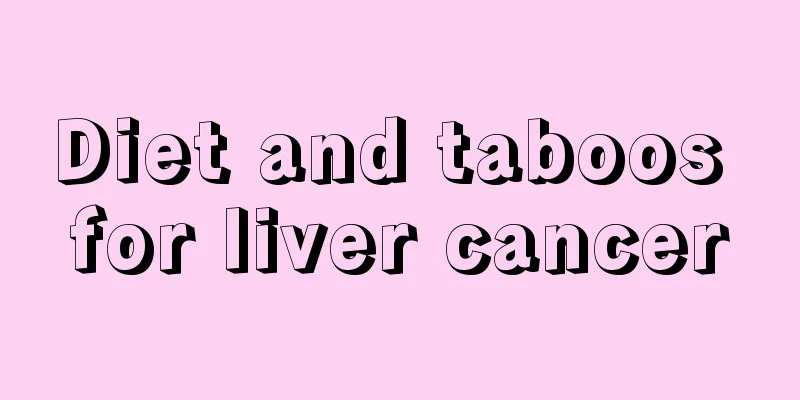Which foods have the risk of inducing liver cancer? Check out foods that are likely to cause liver cancer

|
Aflatoxin, the most powerful carcinogen Aflatoxin is a metabolite produced by Aspergillus flavus and Aspergillus parasiticus. It is one of the strongest chemical carcinogens found so far, mainly damaging the liver and has strong carcinogenic, teratogenic and mutagenic effects. When grain is not dried in time or stored improperly, it is often easily contaminated by Aspergillus flavus or parasitic Aspergillus and produces such toxins. After aflatoxin enters the body, the amount in the liver is higher than that in other tissues and organs, indicating that the liver may be most affected by aflatoxin. It can also be detected in the kidneys, spleen and adrenal glands. If aflatoxin is not ingested continuously, it generally does not accumulate in the body. About one week after a single ingestion, most of it will be excreted through breathing, urine, feces, etc. The main contaminant in food is aflatoxin Bl, and its toxicity is generally considered to have three clinical characteristics: acute poisoning, chronic poisoning and carcinogenicity: ◇Acute poisoning: It is a highly toxic substance, 10 times more toxic than KCN and 68 times more toxic than arsenic. It is second only to botulinum toxin and is the most toxic mold known so far. Its toxic effects on any animal are mainly in the liver, showing acute hepatitis, hemorrhagic necrosis, fatty degeneration of hepatocytes and bile duct hyperplasia. The spleen and pancreas also have mild lesions. ◇Chronic poisoning: Long-term intake of small doses of aflatoxin can cause chronic poisoning. The main changes are chronic liver damage, such as hepatocyte degeneration and cirrhosis. Animals may also experience a series of symptoms, such as slow growth and development, weight loss, infertility or small litters. ◇Carcinogenicity: Aflatoxins (AFT) are the most carcinogenic chemicals known to date. Carcinogenic characteristics of aflatoxin A has a wide range of carcinogenicity and can induce experimental tumors in fish, poultry, various experimental animals, livestock, primates and other animals; B has a high carcinogenicity, and its carcinogenicity is 10,000 times greater than that of 666; C can induce many kinds of cancer. AFT mainly induces liver cancer. It can also induce gastric cancer, kidney cancer, lacrimal gland cancer, rectal cancer, breast cancer, ovarian cancer, small intestine cancer and other parts of the body. It can also cause teratogenesis. Foods that may cause liver cancer in daily life include: 1. Moldy peanuts, dried potatoes, dried radishes, etc. should be discarded and cannot be eaten by humans, livestock or poultry. 2. Peanut oil and cottonseed oil should not be stored for a long time; when a large amount of grain, oil, or dairy products are suspected to be contaminated by fungi, they should be inspected by the quarantine station and can only be distributed, sold, or consumed after approval. 3. Aflatoxin is mainly found in moldy food. Therefore, you should try to avoid eating moldy food and foods that may be contaminated by mold after long-term storage, especially peanuts, corn, pearl rice, etc.; try to eat less fried food; some stale oils contain malondialdehyde, which can also cause protein structure mutations, causing cells with mutated proteins to lose their normal functions and transform into early cancer cells. 4. Long-term alcoholism or occasional drunkenness are also one of the conditions that promote the occurrence of liver cancer. Liver cancer patients are usually alcoholics or have infectious diseases such as hepatitis. Having healthy eating habits and controlling alcohol intake can reduce the risk of liver cancer. Drinking alcohol is very harmful to the liver, pancreas and stomach. If carriers of hepatitis B virus and hepatitis C virus drink alcohol, alcohol can promote the integration of hepatitis B virus and hepatitis C virus into liver cells, causing normal liver cells to mutate and become liver cancer cells. Therefore, drinking less alcohol and eating more dairy products and fresh fruits can reduce the possibility of people getting liver cancer. 5. Stale oils all contain a chemical component that can cause the structure of proteins to mutate, causing cells with mutated proteins to lose their normal functions and transform into early cancer cells. In addition, the replication of acids in some chemical components accelerates the aging process. Therefore, animal and vegetable oils should not be stored for too long. Oils that have deteriorated and have a rancid smell should not be eaten. |
>>: Does eating raw soy sauce have a risk of liver cancer? 6 tips to relieve liver cancer pain
Recommend
The value of pain in the early diagnosis of pancreatic cancer
The pancreas is located deep inside the body, and...
What harm does nail polish do to the body
Nowadays, the pursuit of beauty has extended to e...
Can the burn ointment still be used if it expires?
No matter what medicine it is, it has a certain s...
How to care after colon cancer surgery
When colon cancer occurs, don't be careless. ...
How long can you live without treatment for advanced lung cancer? How should lung cancer be treated?
Lung cancer is a common cancer in daily life. Mos...
The difference between electric hair and perm
I believe that many people often have beauty trea...
How to treat Yang deficiency and fear of cold
Traditional Chinese Medicine is an important cont...
How to distinguish the early lung symptoms of lung cancer
The early symptoms of lung cancer are divided int...
What to eat if total cholesterol is high
Total cholesterol is the sum of cholesterol in th...
What is the use of dental floss
Many people feel that there are a lot of food res...
What are the self-examination methods for the early symptoms of uremia?
As we all know, uremia is very harmful to human h...
Skin care products suitable for 18-year-olds
18 years old is the best age in a person's li...
How to eat pig kidney and Eucommia ulmoides to nourish the kidneys?
Since ancient times, my country has had many famo...
Does adolescent osteosarcoma affect life expectancy?
The body is our capital, and health is what we pu...
What are the early signs of brain atrophy
Because brain atrophy can cause great harm, we sh...









